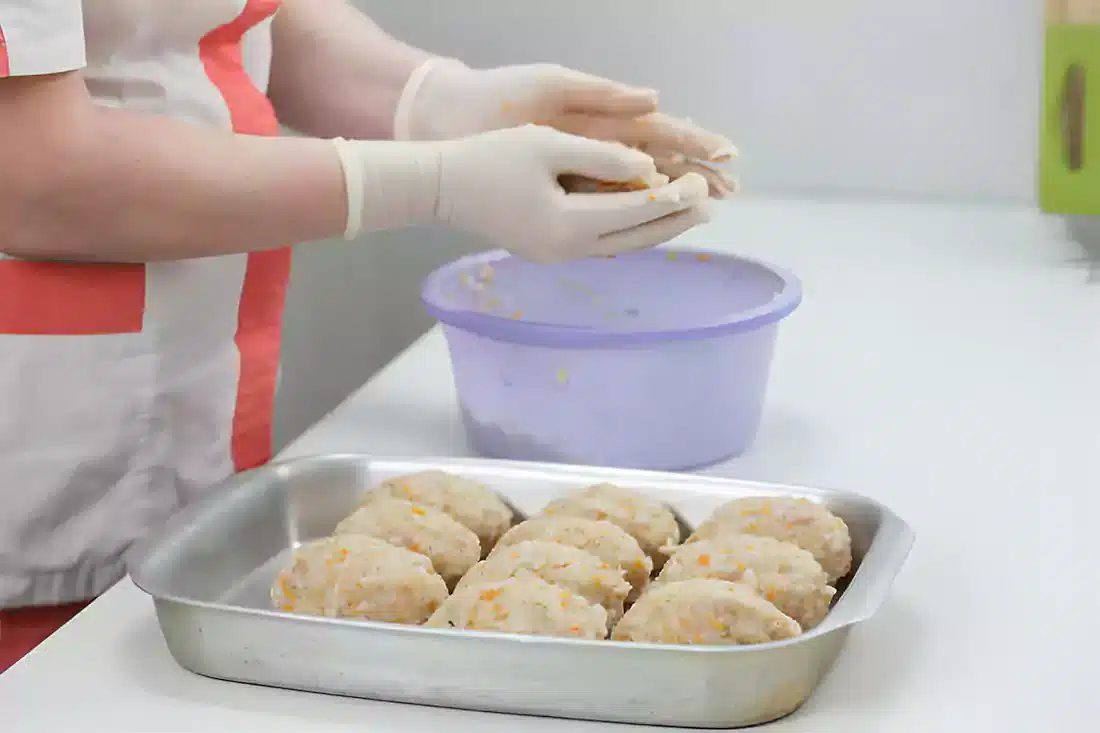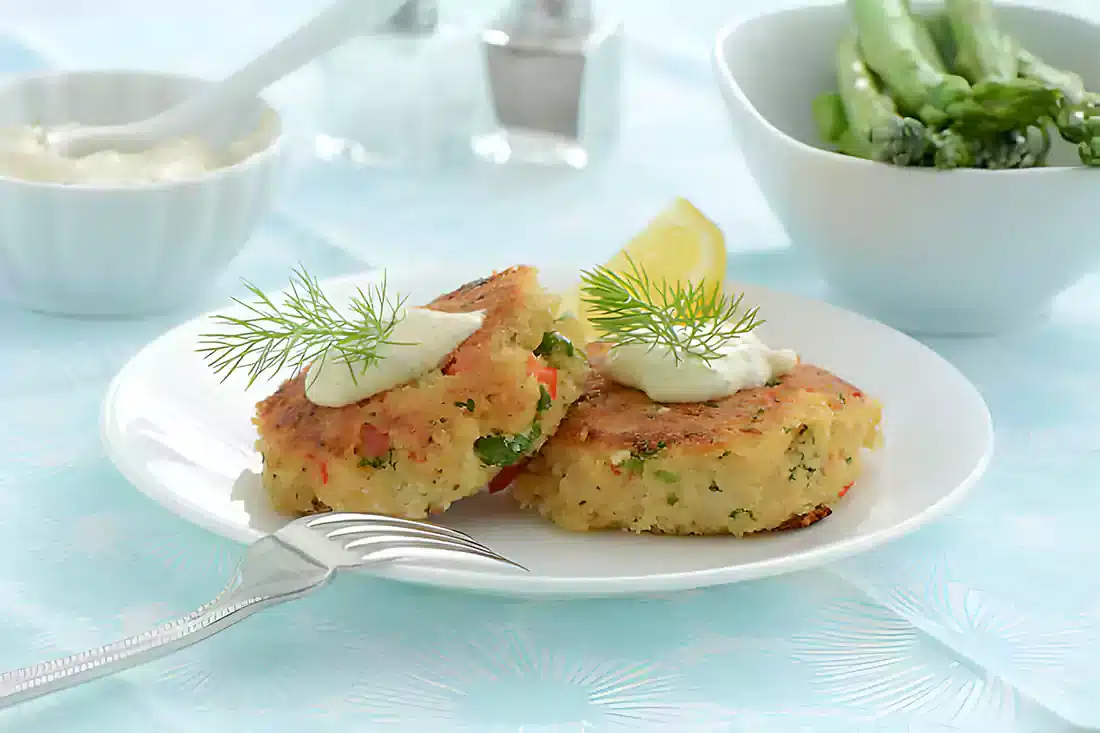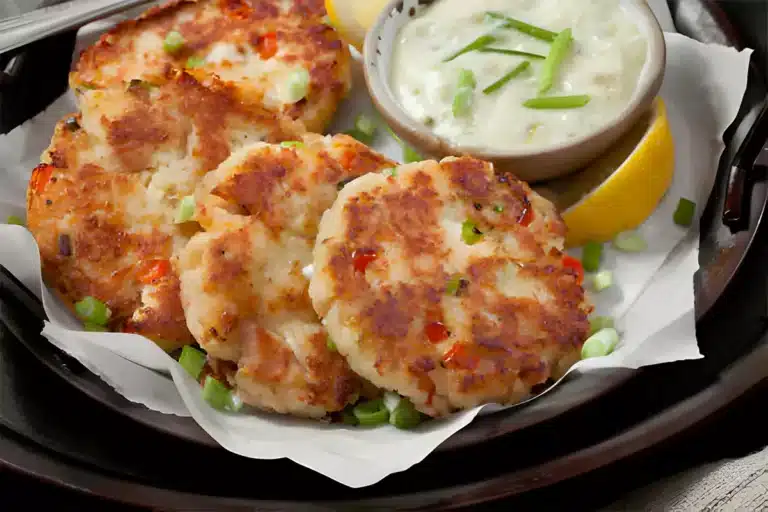Introduction to Crafting the Perfect Crab Cake Recipe
Firstly, discover the art of the perfect Crab Cake Recipe, a dish rich in history and flavor, cherished along America’s crab-abundant coastlines. What sets apart a crab cake? At its core, it combines succulent crab meat, select seasonings, and a binder, all cooked to a golden crisp. This foundational blend, however, opens up a world of variations, transforming the simple crab cake into a gourmet experience.
The Rich History and Origin of the Classic Crab Cake Recipe
Initially, the journey of the crab cake recipe begins in the early days of American history, with roots deeply embedded in the culinary traditions of Native Americans and European settlers. These pioneers of the palate combined local ingredients with traditional cooking methods to create what we now know as the crab cake. Fast forward to today, and crab cakes have become synonymous with the state of Maryland, often hailed as the crab capital of the United States, a sentiment echoed by renowned chefs and culinary experts alike (Food & Wine). Here, crab cakes are not just food; they’re a cultural icon, a celebration of the Chesapeake Bay’s bountiful harvest.
Regional Variations of Crab Cake Recipes
Moreover, while Maryland crab cake recipes might be the most famous, this delectable dish has found its way into the hearts and kitchens of seafood lovers across the globe. From the spicy, zest-infused versions in Louisiana to the more minimalist, crab-forward interpretations found along the Pacific Northwest, crab cakes reflect the tastes and traditions of the regions they hail from, much like the diverse range of bundt cake recipes found across different cultures. Each variation tells a story, a culinary narrative that speaks to the diversity and adaptability of this beloved dish.
As we delve deeper into the world of crab cakes, remember, it’s not just about following a recipe to the letter. It’s about embracing the spirit of culinary exploration, understanding the essence of each ingredient, and, most importantly, adding your unique touch to this timeless classic. So, let’s set sail on this flavorful voyage, armed with a spatula in one hand and an appetite for discovery in the other.
Essential Ingredients for a Delicious Crab Cake Recipe
Furthermore, crafting the perfect crab cake recipe is akin to a symphony, where each ingredient plays a crucial role in the final masterpiece. The key? Balance and quality. Let’s dive into the essentials that make up the soul of a crab cake.
Selecting the Right Crab Meat for Your Crab Cake Recipe
Importantly, when it comes to crab cake recipes, not all crab meat is created equal. The star of the show is undoubtedly lump crab meat, prized for its delicate texture and sweet flavor, similar to how different cakes require specific ingredients as detailed in our guide on bundt cakes., a choice ingredient in top-tier recipes like those featured in prestigious culinary publications (Food & Wine). This premium choice, often harvested from the blue crabs of the Chesapeake Bay, offers large, succulent pieces that give crab cakes their signature chunky texture. For those looking to indulge, jumbo lump crab meat takes it a step further, with even larger chunks that promise a mouthful of crab in every bite.
For the best crab meat, prioritize freshness. Opt for fresh-off-the-boat crab for a taste closest to the sea. If that’s not available, refrigerated options are a good alternative, but avoid canned varieties with additives that can overpower the delicate crab flavors.
Key Ingredients for a Flavorful Crab Cake Recipe
In any crab cake recipe, a few key players come together to bind and enhance the cakes:
- Binding agents: Eggs and mayonnaise not only help hold the crab mixture together but also add a rich, creamy texture that contrasts beautifully with the crispy exterior.
- Flavor enhancers: A dash of Dijon mustard, a sprinkle of Old Bay seasoning, and a handful of fresh parsley elevate the crab meat, adding depth and complexity to the cakes.
- Fillers: While purists might balk at the idea, a modest amount of bread crumbs or Panko can help stabilize the cakes without overshadowing the crab. The goal is to use just enough to bind, not dominate.
Understanding the Role of Fillers in Crab Cake Recipes
Consequently, the age-old crab cake filler debate is about finding the right balance. Fillers, when used wisely, provide structure without overpowering the crab’s flavor. The key is to avoid excessive fillers that make it more of a bread cake or too few that risk falling apart. However, a great crab cake’s essence lies in the perfect harmony of quality ingredients. From succulent crab meat to the subtle touch of Old Bay, these elements will be crafted into beloved crab cakes in the next section.
A Step-by-Step Guide to the Ultimate Crab Cake Recipe
Finally, with our ingredients at the ready, it’s time to roll up our sleeves and delve into the heart of crafting a crab cake recipe, much like the detailed process outlined in our bundt cake essentials guide. This step-by-step guide will walk you through the process, ensuring that each crab cake is a testament to your culinary prowess.

Mixing Ingredients: The First Step in Your Crab Cake Recipe
- Combining the Ingredients: Start by whisking together the eggs, mayonnaise, Dijon mustard, Worcestershire sauce, Old Bay seasoning, salt, finely diced celery, and chopped fresh parsley in a large bowl. This concoction serves as the flavorful glue that will hold our crab cakes together.
- Adding the Crab Meat: Gently fold in the lump crab meat, taking care not to break those precious lumps. This is where the magic happens, as the crab intertwines with the seasoning blend, promising a burst of flavor in every bite.
- Incorporating the Filler: Sprinkle in the Panko or bread crumbs and fold the mixture delicately. Remember, the filler is just a guest in the crab cake party, not the host. It should be just enough to bind, not dominate.
Shaping and Cooking: Perfecting Your Crab Cake Recipe
- Shaping the Cakes: With a gentle touch, shape the mixture into cakes, about ½ cup each, following expert advice to avoid overpacking for pure crab cake bliss (Andrew Zimmern’s Tips). The size is up to you, but remember, consistency is key for even cooking. Place them on a baking sheet and let them chill in the refrigerator for at least an hour. This chilling time is crucial—it’s what helps the cakes maintain their shape during cooking.
- Cooking the Cakes: Heat a nonstick pan over medium heat and coat it lightly with oil. Once hot, place the crab cakes in the pan, cooking until golden brown, about 3 to 5 minutes on each side. The sizzle as they hit the pan, the golden crust forming—this is where the anticipation builds.
The transformation from a simple mixture to a golden, crispy crab cake is nothing short of culinary alchemy. Additionally, each step, from the careful folding of the crab meat to the patient chilling, plays a pivotal role in achieving the perfect texture and flavor.
As you master these steps, don’t be afraid to infuse your personal touch. Cooking, after all, is an art, and every artist has their signature. Whether it’s a special seasoning or a unique cooking technique, what matters most is the love and care you pour into each crab cake. In the next section, we’ll explore the finishing touches that elevate a good crab cake to a great one—the art of serving and accompaniments.
Crab Cake Ingredients:
- 1 pound lump crab meat (fresh or high-quality refrigerated)
- 2 large eggs
- 2½ tablespoons mayonnaise (best quality you can find)
- 1½ teaspoons Dijon mustard
- 1 teaspoon Worcestershire sauce
- 1 teaspoon Old Bay seasoning
- ¼ teaspoon salt
- ¼ cup finely diced celery (from one stalk)
- 2 tablespoons finely chopped fresh parsley
- ½ cup panko (Japanese breadcrumbs) or regular breadcrumbs
- Vegetable or canola oil, for cooking
Directions for Crab Cakes:
- Prepare the Mixture:
- In a large bowl, whisk together the eggs, mayonnaise, Dijon mustard, Worcestershire sauce, Old Bay seasoning, salt, diced celery, and chopped parsley until well combined.
- Gently fold in the lump crab meat and panko, being careful not to overmix to preserve the lumps of crab meat.
- Shape the Crab Cakes:
- Shape the mixture into 6 large crab cakes (about ½ cup each) or 12 smaller cakes, depending on your preference.
- Place the shaped crab cakes on a lined baking sheet and refrigerate for at least 1 hour to help them set.
- Cook the Crab Cakes:
- Heat a large nonstick skillet over medium heat and coat with a thin layer of oil.
- Once the oil is hot, carefully place the crab cakes in the skillet and cook until golden brown and crispy, about 3 to 5 minutes per side.
- Serve warm with tartar sauce or your choice of accompaniment.
Tartar Sauce Ingredients:
- 1 cup mayonnaise (best quality you can find)
- 1½ tablespoons sweet pickle relish
- 1 teaspoon Dijon mustard
- 1 tablespoon minced red onion
- 1-2 tablespoons lemon juice, to taste
- Salt and freshly ground black pepper, to taste
Directions for Tartar Sauce:
- Combine Ingredients:
- In a small bowl, whisk together the mayonnaise, sweet pickle relish, Dijon mustard, minced red onion, and lemon juice until well blended.
- Season and Chill:
- Season the tartar sauce with salt and pepper to taste.
- Cover and refrigerate until ready to serve with the crab cakes.
This recipe strikes a balance between the rich, savory flavors of the crab and the zesty, creamy tartar sauce, making for a delightful seafood dish. Enjoy your cooking!
Serving and Accompaniments
The journey from mixing bowl to dinner plate is nearly complete. Now, it’s all about presentation and pairing, turning a simple crab cake into a feast for the senses.

Homemade Tartar Sauce Recipe
No crab cake is truly complete without its faithful companion, tartar sauce, a sentiment shared by culinary aficionados and chefs alike (Food & Wine). This zesty condiment, with its creamy base and tangy pickles, is the perfect counterbalance to the rich, savory flavors of the crab.
- Ingredients:
- 1 cup high-quality mayonnaise
- 1½ tablespoons sweet pickle relish
- 1 teaspoon Dijon mustard
- 1 tablespoon minced red onion
- 1-2 tablespoons lemon juice, to taste
- Salt and freshly ground black pepper, to taste
- Preparation:
- In a small bowl, whisk together the mayonnaise, sweet pickle relish, Dijon mustard, minced red onion, and lemon juice.
- Season with salt and pepper according to your taste preferences.
- Cover and chill in the refrigerator until ready to serve. The flavors meld beautifully as they sit, creating a tartar sauce that’s both refreshing and rich.
Serving Suggestions
When it comes to serving crab cakes, the possibilities are as vast as the ocean, and for more inspiration on pairing and presentation, check out our key lime pie guide. Here are a few ideas to get you started:
- Light and Fresh: Pair with a crisp, green salad dressed in a light vinaigrette. The freshness of the greens complements the richness of the crab cakes, creating a balanced meal.
- Hearty and Comforting: Serve alongside roasted vegetables or a creamy potato salad. These heartier sides can stand up to the bold flavors of the crab cakes, making for a satisfying meal.
- Elegant and Sophisticated: For a touch of elegance, consider serving crab cakes over a bed of arugula with a drizzle of remoulade sauce. Add a glass of crisp, white wine, such as a Sauvignon Blanc or Chardonnay, to elevate the dining experience.
Remember, the key to a great pairing is balance. The sides should complement, not compete with, the delicate flavors of the crab cakes. Whether you opt for simplicity or sophistication, let the crab cakes be the star of the show.
Advanced Tips and Variations
Now that we’ve covered the basics, let’s elevate our crab cake game with some insider tips and creative variations. These nuggets of wisdom will help you fine-tune your crab cakes, making them a dish to remember.
Secrets to Perfect Crab Cakes
- Moisture Control: Achieving the perfect crab cake with a crispy exterior and moist interior is all about managing moisture. Too much liquid makes them fall apart, while too little leaves them dry. A helpful tip is to gently press the crab meat to remove excess liquid before mixing, preserving the meat’s quality.
-
Variations of Crab Cake Recipes
- Regional Variations: Embrace the flavors of different regions by tweaking your crab cake recipe. Add a dash of Cajun seasoning for a Louisiana twist, or incorporate some finely chopped green onions for a Pacific Northwest touch. Each region brings its unique flair to this classic dish.
- Gluten-Free and Keto-Friendly Adaptations: Accommodating dietary restrictions doesn’t mean sacrificing flavor. For a gluten-free version, swap out the breadcrumbs for a gluten-free alternative or even finely ground almond flour. For those following a keto diet, pork rind crumbs can be a surprisingly effective binder that adds an extra layer of flavor.
These advanced tips and variations not only enhance the flavor and texture of your crab cakes but also allow you to tailor them to your taste preferences and dietary needs, similar to the adaptability seen in our Amish macaroni salad recipe. Experimenting with different ingredients and techniques is part of the joy of cooking, turning each meal into a creative endeavor.
FAQs (People Also Ask)
In the world of crab cakes, questions abound. First of all, from selecting the right type of crab meat to ensuring your cakes don’t fall apart in the pan, let’s tackle some of the most common queries.
What is the best type of crab meat for crab cakes?
The consensus among crab cake connoisseurs is that lump crab meat or jumbo lump crab meat is the gold standard. These varieties offer sizable, succulent pieces of meat that provide texture and flavor unmatched by other types. Remember, freshness is key, so opt for crab meat that’s as fresh as possible, whether it’s straight from the seafood counter or a reputable refrigerated brand.
Can I make crab cakes without mayonnaise?
Certainly! You can replace mayo in crab cakes with options like Greek yogurt or a beaten egg for a similar binding effect without overshadowing the crab’s delicate flavor. Feel free to try different substitutes that match your taste and dietary choices while keeping the cakes together.
How do I prevent crab cakes from falling apart?
The secret to keeping crab cakes intact lies in the balance of ingredients and the chilling process. Ensure your mixture isn’t too wet, and don’t skimp on the binding agents like egg and breadcrumbs. After shaping your crab cakes, refrigerate them for at least an hour before cooking. This step solidifies the cakes, making them less likely to crumble when they hit the heat.
Are crab cakes healthy?
Opt for healthier crab cakes by using fresh, lean crab meat with less filler. Crab offers quality protein and essential nutrients. Reduce mayonnaise and breadcrumbs, and consider baking instead of frying for a healthier option.
With these FAQs addressed, you’re well-equipped to navigate the subtleties of crab cake preparation. Remember, cooking is as much about intuition and personal preference as it is about following recipes to the letter. Trust your instincts, and don’t be afraid to make adjustments based on what feels right to you. In the final part of our crab cake journey, we’ll wrap up with some concluding thoughts and a final sprinkle of culinary inspiration.
Conclusion
As we bring our crab cake exploration to a close, let’s reflect on the journey we’ve embarked upon. First and foremost, from the selection of the finest lump crab meat, to the delicate balance of flavors and textures, crafting the perfect crab cake is an art form. In addition, it speaks to the heart of culinary tradition and innovation.
Recap and Final Thoughts
Crab cakes, as a result, a culinary canvas reflecting history and regionality, demand quality ingredients and care in preparation. Whether crafting classic Maryland recipes or adding personal flair, great crab cakes are born from intention and joy.
Moreover, they celebrate the sea, honor tradition, and showcase the limitless possibilities of cooking. As you experiment and refine your crab cake recipes, each iteration marks your culinary journey. Consequently, it’s a chance to learn, grow, and savor the delicious rewards.
Whether at a family dinner or a sophisticated event, success is measured in smiles and satisfaction. Additionally, cheers to the crab cake—a dish that unites, ignites conversation, and creates lasting memories.
Thank you for joining this crab cake exploration. Additionally, may your kitchen exude crab’s aroma, shared warmth, and culinary discovery. Finally, happy cooking!
